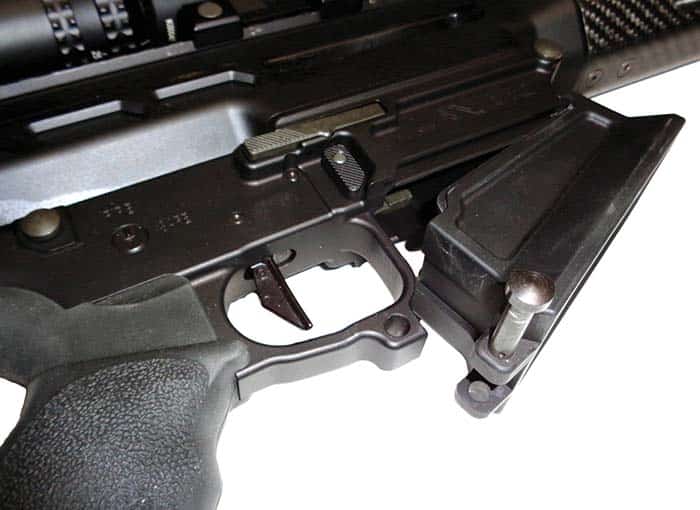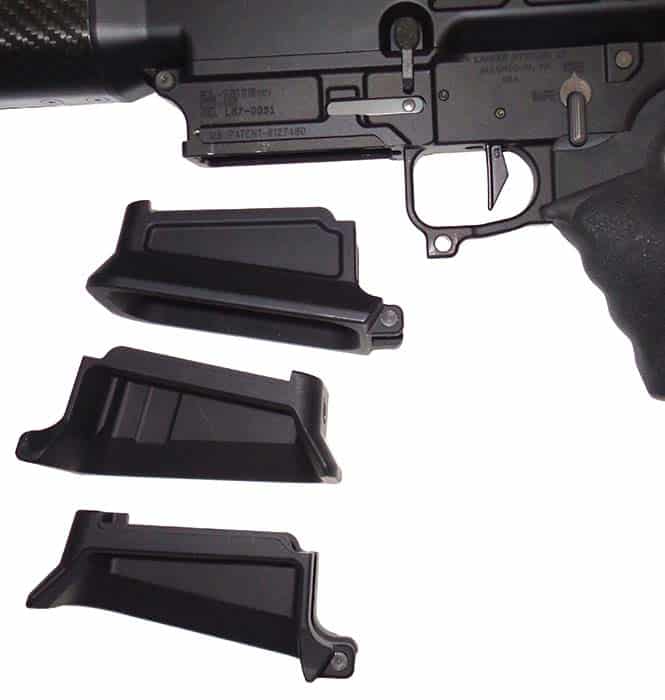The rifle supplied to SAR for test and evaluation was the model Heavy Metal, Notice the carbon fiber stock and handguard which are both manufactured by Lancer. Also notice the Lancer designed Nitrous muzzle brake.
By Christopher R. Bartocci
Lancer Systems has grown rapidly in the industry. Starting as an unlikely small arms company, they worked with Diemaco/Colt Canada in the early 2000’s on the Greene Tweed Project, a new translucent polymer magazine nicknamed the “green” magazine. After a minor hiccup in the development process of the magazine, the insert molded metal feed lips separated from the polymer magazine body when DEET (bug spray) was applied to the magazine causing crazing and cracking around the insert: this eventually lead to failed retention of the loaded ammunition. Colt Defense, who now owned Colt Canada dropped the program. Lancer knew they had a product they could sell and released the Lancer L5 magazine in 2007. This magazine was offered in smoke translucent color. As they got recognized they rose to become one of the most popular and durable magazines in the industry. This author has followed the development of the Lancer magazines quite closely from the original prototype magazines. This author has tested extensively all generations of the L5 magazine in 2011 with nothing other than excellent results. The L5 magazine is certainly a major step up from the standard GI aluminum magazines. To start with, the shot column is a constant curve shape. This is the natural shape in which the cartridges stack on top of each other unlike the GI magazine where you have a straight, unnatural shape on the top of the magazine and then it goes into a curve once the magazine extends beyond the bottom of the magazine well. This gives more constant and reliable feeding. Also the polymer material is more lubricious and causes less friction than the aluminum magazine. The texture of the magazine is a drastic improvement over the aluminum magazine. The trademark magazines are translucent allowing the shooter to visibly see how many rounds are in the magazine. This goes back to the concept of the original prototype magazine that Lancer worked on with Diemaco/Colt Canada. What separated the L5 from the normal polymer magazine was that they used a hybrid design incorporating steel feed lips which were an insert molded into the polymer. Initially these were separate tabs. The next upgrade came in the form of the newly released L5 AWM or Advanced Warfighter Magazine. This is an updated L5 with the major change being a much larger and more durable feed lip insert. These have gone on to be one of the finest magazines in the industry. They are offered in 5, 10, 20 and 30 round capacities.
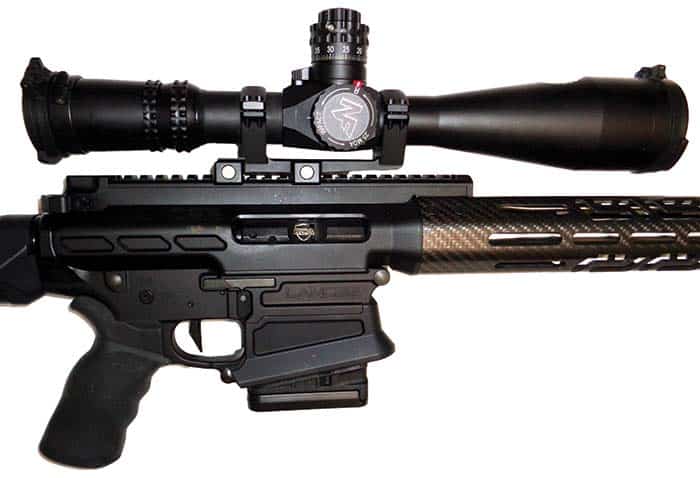
With the surge in modern sporting rifle sales, Lancer decided to take their experience in carbon fiber production to manufacture carbon fiber handguards. These were an instant success being purchased and installed by original equipment manufacturers. In 2012, Lancer launched into the AR-rifle business. These are not just assembled rifles from other company components but their own take on the rifle. The first rifle offered was the L15 rifle chambered in 5.56mm. The lower receiver was really the heart and soul of the Lancer rifle. The receiver has removable magazine well adapters allowing for different adapters which would include an oversized magazine well bevel. The lower receiver also sported an ambidextrous bolt release above the extended magazine release button on the right side of the lower receiver. Several models were offered. They would include Lancer Carbon Fiber handguards and some had stocks made of this material as well. The rifles were more geared towards the 3-gun competition market. The fast handling lightweight rifles really shined in this capacity and pricing was competitive with other manufactures in this market but offered out of the box performance that no other manufacturer could match.
In 2014, Lancer introduced their newest member of their lineup of rifles, the long anticipated L30 family of weapons. This is their 7.62x51mm (.308 Win) caliber family of weapons. Like the L15-Series rifles, these too are based upon carbon fiber technology. The rifle sent to SAR for review is the Heavy Metal (L30 HM) version of the rifle. The L15 family of rifles uses the legacy direct gas impingement operating system which has been preferred for precision rifles. This 9.5 pound rifle will certainly qualify as a Designated Marksman Rifle. Both the Lancer upper and lower receiver are compatible with the DPMS pattern receivers.
Starting at the rear of the rifle, the stock is the carbon fiber Lancer LCS fixed stock. The stock is 10.8 inches long and weighs just 10.4 ounces. The materials used in the manufacturing of the fiber stocks and handguards is Epoxy / Carbon fiber 2 X2 Twill. There is a quick detachment point that works on either side of the stock as well as standard soft sling attachment slots. These can be had in A1 or A2 length. The lower receiver itself is manufactured from a billet of 7075 T6 aluminum. This is a proprietary lower receiver that has all the advanced features of the L15 rifle. This includes the ambidextrous bolt release. Also there is an oversized magazine release on the right side as well. Also just like the L15, the L30 has replaceable magazine well adapters. The L30 comes with the tactical magwell but the owner can purchase the other models. The first magazine well is called the Competition magwell. This one has a large bevel which will allow quick inserting of magazines. This would be very bulky for a combat rifle but perfect for the competitor. The next is the Tactical magwell. This is more of an in-between a Standard magwell and a Competition magwell. The third is the standard magwell which mimics the standard receiver. The fourth is the L30 LTR which is adaptable to either right or left hand shooters. It has a side cut out so larger capacity magazines can be removed and inserted in the prone position without the rifle being taken off target. The pistol grip on the tested rifle is the ErgoGrip Tactical Deluxe grip.

Lancer does offer different trigger options depending upon the model offered. The Heavy Metal rifle received has a Geissele SD3G or Super Dynamic 3 Gun trigger group. This trigger has a very short, light pull and reset. It is designed specifically for close course competition where rapid target engagement and quick follow-up shots are required. This is a single stage trigger. The weight is determined by which hammer spring is used. Either a 3.25 or 4 pound spring is used for that overall trigger pull weight. It should be noted this trigger should not be used for duty use, bench rest, accuracy work or shooting small groups. This trigger is not adjustable.
The upper receiver is also manufactured by Lancer. This also is manufactured from a billet of 7075 T6 aircraft grade aluminum. It is unique in the fact there is no ejection port dust cover and forward bolt assist. The fired cartridge case deflector is built into the octagon shape of the upper receiver. These things were eliminated to save weight. The forward assist was removed as most precision shooters will not force a round into the chamber if there is a malfunction. This type of action by forcing a cartridge in the chamber often results in failure to extract. This receiver is also manufactured of billet 7075 T6 aircraft aluminum. The handguard is the 15 inch Lancer Carbone fiber handguard. There is a Mil-Std-1913 rail segment on the top end of the handguard for proper alignment of a front back up iron sight. The barrel is completely free floated inside the lightweight handguard.

This is the lightweight and more compact L30 MBR (L30-RFL-MBR). Notice the shorter 16 inch barrel. 
This is the extreme long range Lancer LTR (L30-RFL-LTR-308) rifle. Notice the 24 inch barrel and the KFS adjustable TACMOD stock.
The barrel of the Heavy Metal is a broached cut stainless steel barrel which is manufactured by White Oak Armament. Barrels for the MBR rifle are manufactured by CMMG. The barrel has a 1 turn in 10 inch right hand twist. The range of the Heavy Metal is easily 800 yards. Barrel life is dependent on several factors including rate of fire, cleaning and type of ammunition. The LTR model has a 1 turn in 11.5 inch twist 24 inch Bartlein barrel which will easily reach out to 1,000 yards. The Heavy metal barrel is topped off with the Lancer designed Nitrous muzzle brake. The design of the Nitrous muzzle brake incorporates a progressive aperture; getting smaller at each baffle moving toward the end. This helps evenly distribute the gas pressure in the chambers and optimizing recoil reduction. The compensator also incorporates and initial chamber with 2 upward facing thread ports; interchangeable jets are used to reduce the muzzle climb. Lancer offers another model of muzzle brake called the Viper. This was released in 2014 and uses the same technology as the Nitrous. The brake was increased in size and the chamber is designed to drive more gas pressure rearward thus providing increase recoil reduction. In addition the top ports were rotated off centerline to ensure the user maintains a clear field of view through their scope when firing. The Viper has an MSRP of $169.99 and is offered in black or stainless steel. It is offered in 6.5 or .308 caliber.
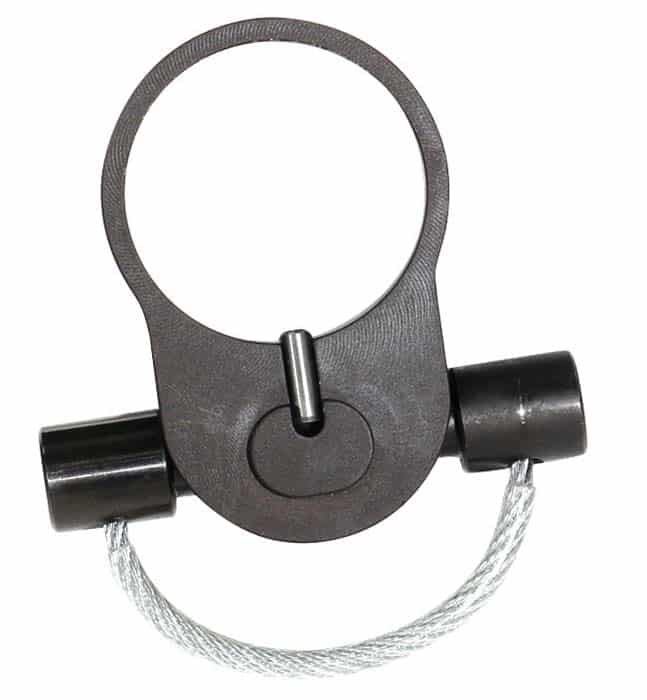
The bolt carrier group is a DPMS pattern and is manufactured coated in black nitride by Rubber City Armory. The quality of the carrier group is very nice and the carrier key is properly staked.
At the same time the Heavy Metal arrived it also arrived with some other new Lancer products. First was the single point sling adapter. This is a modified receiver extension end plate. What makes this unique is that it is made using a nylon coated wire cable instead of steel. This has the benefit due to the nylon coating that noise is reduced. The cable is also flexible offering more maneuverability.
The next product was a highly anticipated product. In 2014 Lancer finally introduced their L7 SR25/AR10 magazine in 7.62x51mm/.308 Win caliber. Based on the technology of the L5 AWM and MPX magazines, The L7 was scaled up for the larger caliber. The steel insert is much larger and encompasses the mag catch area. There is a stainless steel insert or front guard in the front of the magazine. The front guard serves several purposes; first it protects the magazine from damage in high volume automatic fire (Competitor sample magazine used in high volume firing had dimpling or grooves cut into the magazine). Secondly the front guard acts as a foundation for the feed lips; after welding you end up with a full steel top end which is very stable and robust. The first magazines offered were the 20 and 10 round capacity magazines. They were offered in the proprietary translucent material allowing the shooter to see how many rounds are in the magazine. These are offered in clear as well as a smoke color. Also offered are a black, an olive drab green and a tan opaque variation manufactured from glass filled nylon. In 2015 SHOT Show, Lancer introduced their new 25 round magazine which was not scheduled to be available till September of 2015. SAR got a first look at this new magazine. It is manufactured to the same standards as the 20 round magazine but longer. This is by far the most robust magazine of the sort in the industry. The L7AWM are heavier and bulkier than other magazines in this class. However compared to steel magazines, the L7AWM magazines are lighter in weight. They are on a new level of durability compared to the rest. Lancer did not choose to compromise durability to save weight.
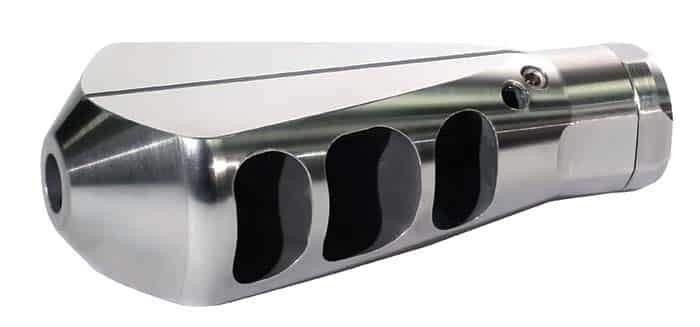
Shown is the Lancer Viper muzzle brake. 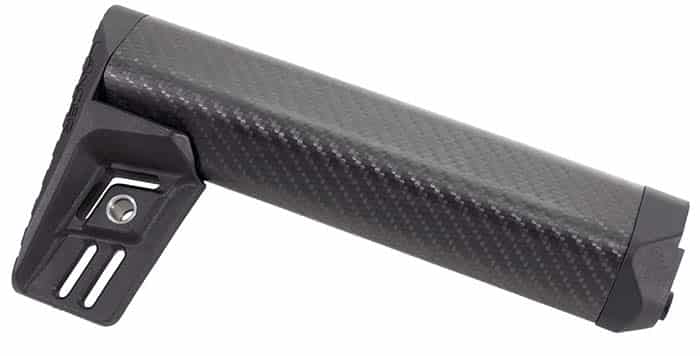
This is the Carbon Fiber stock designed and manufactured by Lancer, the Lancer LCS is available in both A1 and A2 lengths.
The scope chosen is the Night Force BEAST. BEAST is an acronym for Best Example of Advanced Scope Technology. The BEAST is a 5-25 x 56 F1 with a tube diameter of 34mm/1.34 inches. The objective outer diameter is 65mm with an exit pupil diameter of 5x: 8.3mm and 25x at 2.3mm. The eyepiece outer diameter is 46mm. The field of view at 100 yards is 5x@18.7 ft and 25x@ 4.92 feet. Eye relief is 3.35 to 3.54 inches. The internal adjustment range for elevation is 120 MOA and windage 80 MOA. Each click is .50 and .250 MOA. The parallax adjustment is 45 yd-∞. The optics are crystal clear. This would be a standard of excellence in long range rifle optics.
The rifle came with both 20 and 10 round Lancer L7 magazines. The rifle was also tested with other magazines to determine compatibility. These magazines included Magpul Gen 2 & 3, CProducts Defense, ASC and D&H Tactical. There were no malfunctions of any sort with all of the magazines used in the rifle.

The rifle was first function tested with 200 rounds of Federal XM80 147gr 7.62x51mm M80 ball cartridges. There were no malfunctions of any sort. This ammunition was not particularly shot for group size but it always was under 1.50 inches at 100 yards. The rifle was then placed on a bench rest and loaded with Black Hills Ammunition 7.62x51mm 175gr OTM ammunition. Black Hills Ammunition is known for making some of the most consistent and precision ammunition in the industry and is the go-to company for many in the US military and Special Operations Command when they need something, let’s say different from the norm. This author has used Black Hills Ammunition extensively over the years and finds it to be top tier. The Lancer Heavy Metal consistently shot an average of .450 inches at 100 yards. The recoil was typical but it was clear the muzzle brake did function as advertised. Like always with a muzzle brake you sacrifice noise for muzzle jump and recoil. The Nitrous muzzle brake was no different. The benefit of the muzzle brake was certainly worth the trade off in noise in this case.
The rifle was lightly lubricated with G96 CLP. This is the current CLP in use by the US military and it is referred to as the Mobile 1 of CLP due to that is all synthetic. This CLP is in full compliance with Mil-PRF-63460E and in fact it exceeds it. So much that during the competition, the part of the requirement that required protection from corrosive primers and propellants could not be matched by the other producers. Only G96 met that requirement. It was dropped so the government could have additional sources of CLP. However G96 would not downgrade their formula, it remains with this additional component. The rifle functioned flawlessly throughout all testing.

Lancer offers three different variations in the L30 family of rifles. The first is the rifle that was sent to SAR for testing, the Heavy Metal (L30-RFL-HM). This 9.5 pound rifle has an 18-inch, 1 turn in 10 inches White Oak Armament stainless steel barrel and Nitrous muzzle brake with a 15 inch Lancer L30 Carbon Fiber handguard. The rifle has an adjustable direct gas rifle length gas system and a Geissele SD3G trigger. This rifle has an MSRP of $3,344.99 . The second is the long range L30 LTR (L30-RFL-LTR-308). This 12.5 pound rifle has a 24 inch 1 turn in 11.25 Bartlein heavy profile barrel and Viper muzzle Brake with a 18 inch Lancer L30 Carbon Fiber handguard. The rifle has an adjustable direct gas rifle length gas system and a Geissele Hi-Speed National Match trigger. The stock is different on this one, it is a KFS Adjustable TACMOD. The MSRP on this rifle is $4,199.99 . The third model is the L30 MBR (L30-RFL-MBR). This 9 pound rifle has a 16 inch mid weight 1 turn in 12 inch twist barrel and Nitrous muzzle brake with a 12 inch Lancer L30 Carbon Fiber handguard. The rifle has a rifle length gas system and a Mil-Spec trigger. The stock is a B5 Sopmod Bravo. The MSRP of this rifle is $2,599.99.
Lancer has been a major player in the magazine business. Their L5AWM and L7AWM magazines are used by original equipment manufacturers such as LaRue, Wilson Combat, Handl Defense and Adams Arms to name a few. Their components such as carbon fiber stocks and handguards are popular with match shooters. Now they are in the complete firearms market. Not just making the same rifle as everyone else, but finding their niche in competitive shooting. Lancer has active product development and is constantly coming up with new products. The magazines have achieved very high status and are trusted by military and law enforcement. They offer competitive pricing for their magazines as well. Their complete rifles are expensive, but they are far from stock rifles. They are highly customized rifles using the most modern manufacturing techniques. You will not use a Lancer rifle to shoot cans on the weekend, but if you are competing in long range or 3-gun matches, Lancer is a gun to beat. Lancer rifles have found their way into the law enforcement market as well. The commercial market is quite vast in their applications for the Lancer rifles as well. Everything from competition, target shooting, hunting and personal protection Lancer will have a rifle for you.
| This article first appeared in Small Arms Review V20N2 (March 2016) |





